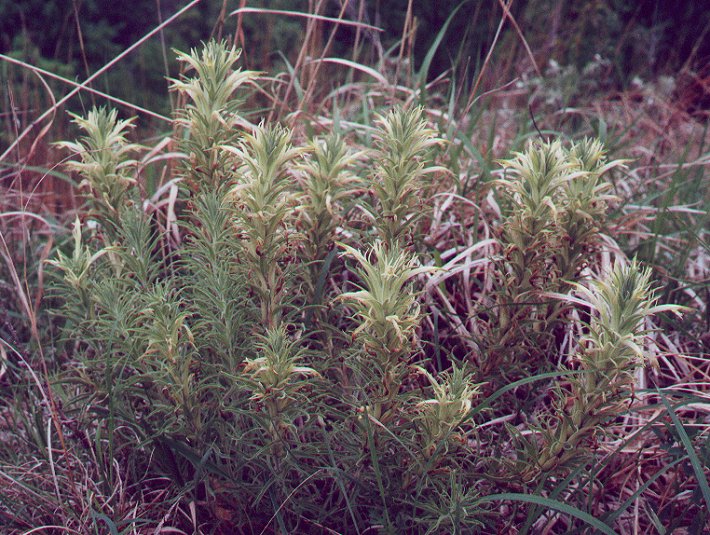Castilleja sessiliflora Pursh
Downy Painted Cup

Native
CC = 10
CW = 5
MOC = 2
SRank = S2
© DETenaglia
Castilleja sessiliflora PurshDowny Painted Cup | |
 |
Native CC = 10 CW = 5 MOC = 2 SRank = S2 |
© DETenaglia |
|
Family - Orobanchaceae Habit - Perennial forb, sometimes with a woody rootstock, hemiparasitic. Stems - Multiple from base, simple, herbaceous, villous to velutinous or lanate, to +35cm long, erect to ascending, from a stout woody crown with thick roots. Leaves - Alternate, sessile. Lower leaves linear, entire, pubescent above and below, to 8 cm long. Upper leaves (bracts of flowers) 3-4 lobed (typically with two lateral lobes and a central lobe which is often divided), to 6 cm long, pubescent above, dense pubescent below. Lobes entire, linear.
Inflorescence - Single sessile axillary flowers from upper 2/3 of stem. Flowers subtended by a lobed foliaceous bract.
Flowers - Corolla to +5.5cm long, well exserted beyond calyx, pale yellowish-white to light green at apex, bilabiate. Tube to 4cm long, villous near base, glandular pubescent at apex. Lower lip 3-lobed. Lobes attenuate, 4-5mm long. Upper lip 1cm long, galeate, with scarious margins, folded, attenuate. Stamens 4, didynamous. Filaments to 1.2cm long, glabrous, filiform. Anthers yellow-orange, 3-4mm long. Style filiform, glabrous, exserted just beyond upper lip of corolla. Stigma small, dark purple. Ovary superior, glabrous, green, 4-5mm long, slightly compressed. Locules 2. Placentation axile. Calyx tubular, laterally bilabiate, accrescent. Tube to 2.5cm long, light green to pale yellow, glandular pubescent externally, glabrous to sparse pubescent internally. Each lateral lip 2-lobed. Lobes attenuate, to -2cm long, dense glandular pubescent.
Fruits - Capsules 12-17 mm long, dehiscent by two valves, glabrous. Seeds 1-2 mm long, yellowish brown to brown. Flowering - April - July. Habitat - Dry exposed areas of loess hills. Origin - Native to U.S. Lookalikes - None. Other info. - If you want to view this plant in this state you will have to travel up to Holt and Atchison Counties in the northwest corner of the state, the only two counties from which it has been reported. It can be found on the upper ridges of the loess hills in the area. Good luck if you go out there. Elsewhere, the plant's main range is to our west, throughout the Great Plains. Photographs taken at the Jamerson C. McCormack Conservation Area, Holt County, MO., 5-3-00. |